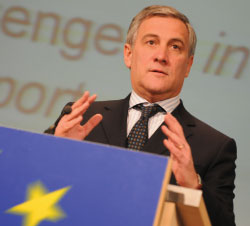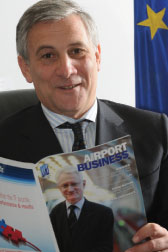
“The role of the aviation sector in connecting the people and businesses of Europe is increasingly important. Aviation is often the only quick transport mode available to link EU citizens over large distances,” said Tajani.
Aviation, the sector with the highest growth rate of all transport modes, will remain a key part of Tajani’s policy. Indeed, he is passionate about aviation, having spent time in the Italian Air Force – working in air defence control, in charge of the operations room, monitoring Italian and European air traffic (civilian and military).
Tajani describes airports as “the gates to the sky” and recognises their role in the aviation system and their contribution to society and mobility. “The European Union now consists of 27 Member States and almost 500 million citizens and the role of the aviation sector in connecting the people and businesses of Europe is increasingly important. Aviation is often the only quick transport mode available to link EU citizens over large distances,” he said.
The creation of the EU aviation market in the 1990s is one of the success stories of the European Union and airports are part of this success, having increasingly played a role in driving airline competition. The sharp increase in the number of routes served in Europe, (+170% since 1993), means more cities and also more remote regions are now served by air transport and thus, connected to the world.

Tajani: “The ‘capacity crunch’ that we face on the ground and in the sky is part of the ‘challenge of growth’ that we face; a challenge that is fundamentally about the industry’s – and Europe’s – competitiveness.”
Competition has also strongly increased – the number of routes with more than two competitors rose by 300% between 1992 and 2006. “As a consequence, passengers have more choice and prices have gone down sharply. Airports have more ‘clients’ than ever before,” said Tajani.
He views hubs and regional airports as having complementary roles, with hubs being the EU’s gateways to the world. “Regional airports have in the last few years become the rising stars of the European air transport system, with astonishing growth rates, which often mirror the success of low-cost carriers,” said Tajani. Importantly, this has been achieved without sacrificing services to more remote parts of the continent. “Airports located at the EU’s periphery are extremely important in helping to secure the mobility of all citizens, not just those close to central regions or big cities.”
Tajani on the environment
The conditions for the inclusion of aviation in the EU ETS remain a cause of extreme concern for airlines and airports in Europe. Tajani considers that a separate regime for aviation with its own cap, as agreed last summer, should be maintained. “Any changes to the aviation regime should take into account the specific characteristics of aviation and preserve the competitiveness of the sector.”
ACI EUROPE undertook an initiative in June whereby Europe’s airports have committed to reducing their carbon emissions with the ultimate objective of becoming carbon neutral. Tajani is highly supportive of this and of ACI EUROPE’s Airport Carbon Accreditation Scheme. “All efforts by European airports to reduce their carbon emissions are certainly welcome and should be encouraged.”
Airport capacity crunch
For aviation, said Tajani, there are three key priorities: Competitiveness; Safety, Security and Sustainability (‘the three S’s’); and International negotiations. “The ‘capacity crunch’ that we face on the ground and in the sky is part of the ‘challenge to growth’ that we face; a challenge that is fundamentally about the industry’s – and Europe’s – competitiveness.”
The Action Plan on airport capacity, efficiency and safety, adopted by the European Commission in January 2007, brought into political focus the importance of airport capacity issues. The first deliverable of the Action Plan was the creation of the EU Observatory on Airport Capacity – the inaugural meeting of which took place on 4 November 2008.
The Action Plan encompasses a set of measures to avoid possible future shortfalls in airport capacity generated by the continuous growth of air traffic; the Observatory will advise the Commission on the implementation of these measures, including infrastructure planning and intermodality. “Every interested party has reacted positively to the establishment of the Observatory. I am therefore convinced that the Observatory will play a leading role in the implementation of the Action Plan. Thanks to its expertise and experience, it will be pivotal in advising the Commission on the relevance of the measures to be implemented,” said Tajani.
As part of their wide-ranging cooperation agreement on airport capacity, ACI EUROPE and EUROCONTROL recently announced a joint Action Plan on the implementation of Airport-Collaborative Decision Making (see article, Pg 11). Tajani welcomed the initiative, but is insistent on the need to guarantee harmonisation and interoperability of any new procedure and equipment, on the need to ensure that new technologies will be implemented in a uniform manner throughout Europe, and that the related standards will not vary from one airport to another. “Safety and cost-efficiency as well are at stake here. And it is only by abiding by the Community framework that we can all benefit from the interoperability of both mature new technologies like A-CDM that airports are implementing right now, and future technologies which are currently under development, notably under the SESAR programme,” he said.
Tajani on Airport Charges
Tajani believes that the Airport Charges Directive will not increase the administrative burden on airports, “as it is based on principles that airports should already be complying with today”. “Indeed, the forthcoming EU Directive on Airport Charges is based on internationally accepted principles, which apply to all airports. Member States have already endorsed these ICAO principles, with no limitations as to their scope. ICAO principles do not create any distinction for airports with a certain position in the market or with a minimum level of traffic.”
SES II – turning legislation into action
In June this year, the European Commission proposed to speed up the creation of the Single European Sky. “Our proposals clearly link capacity in the air and on the ground with the objective of aligning airport capacity with ATM capacity, in order to preserve the overall efficiency of the air transport network,” said Tajani. “The necessary investments in airport capacity will need to be made, but we need to be realistic about what can be achieved; economic and environmental constraints, together with long lead-times for new infrastructure, mean that priority should be given to optimising the use of existing capacity.”
The SES II package is being examined by the European Parliament in its first reading and by the Council. The French Presidency of the EU has dedicated a lot of energy to the package and as a result, there is broad agreement on most of the elements. The European Parliament is expected to cast its vote in early 2009. “We need to act quickly if we want to turn legislation into action,” said Tajani. “I trust we can adopt the package in the first half of 2009 and I will do everything I can to that end.”
European airports and ACI EUROPE are fully supportive of SES II, however, they have expressed concerns regarding the impact of the extension of EASA’s competences to cover aerodrome safety; the operational and cost impact is especially critical. Tajani explained that he understands concerns, notably the fear that the EU would apply a ‘one-size-fits-all’ approach that would create an additional layer of regulation without taking into account existing ICAO standards. However, he was keen to reassure ACI EUROPE member airports that they would not face increased bureaucracy and costs, or a slowdown in procedures.
“Our approach is certainly not to put an additional burden on the airport businesses or to apply a ‘one-size-fits-all’ model. It is to establish the European Aviation Safety Agency as the sole Agency in charge of the entire safety chain in Europe, including airports. A fully-fledged agency is a shared objective by the European Parliament and the 27 Member States,” said Tajani. “We have an excellent safety record in the EU, but we need to work to ensure we maintain and enhance these safety standards in the face of the projected growth in traffic. That said, we do not want to re-invent the wheel: the future rules will be based on ICAO standards.”
The European Parliament and Council are working on a number of issues, such as the scope of the Regulation. The European Commission has proposed a limited scope, whereby only those aerodromes open to the public which can serve IFR (instrument flight rules) traffic, or aircraft above a certain weight, would be subject to Community legislation. “In addition, the implementing rules will take into account the specificities of the different airports, according to, for example, their size, the type or the volume of traffic. They will be adopted by the Commission after an extensive consultation process with all of the stakeholders, to be carried out by EASA, has been completed,” said Tajani.

The EU Observatory on Airport Capacity will advise the European Commission on the implementation of measures to avoid possible future shortfalls in airport capacity, including the planning of infrastructure projects and access to airports, including intermodality with rail.
Liquids, Aerosols and Gels (LAGs) security measures
Progress on the LAGs issue has been slow; so far only two countries – Singapore and Croatia – have received approved exemption status from the EU. Quick progress, explained Tajani, has been delayed because third countries have often faced difficulties in meeting all the EU criteria in a timely manner. However, further site verifications will soon take place and, if a good level of security is confirmed, additional exemptions can be expected.

The European Commission foresees a technological solution to the LAGs issue by April 2010. “The April 2010 deadline is politically very important. ACI EUROPE will have to play a very important supportive role in this matter and will be key in advising the Commission on the achievability of this deadline through use of upgraded screening machines at airports in Europe,” said Tajani.
The US issue will again be on the agenda of the EU Aviation Security Committee very soon. Tajani expressed surprise that some Member States are looking for full reciprocity in the sense that duty free liquids bought at European airports should not face the slightest risk of being confiscated at US airports. “This position ignores the fact that travellers arriving from Europe do have the possibility to put such liquids into hold luggage since customs controls for passengers arriving in the US take place at the airport of entry and not at the point of final arrival,” said Tajani. “I sincerely hope that the situation will be reviewed, and that the derogation will not be delayed. I expect the situation for Canada to be discussed soon once the problems with flights arriving from the US have been settled.”
The European Commission foresees a technological solution to the LAGs issue by April 2010. “A special group is working on this matter and we have now indicated performance parameters to be achieved, to manufacturers of screening equipment” said Tajani. “The April 2010 deadline is politically very important. ACI EUROPE will have to play a very important supportive role in this matter and will be key in advising the Commission on the achievability of this deadline through use of upgraded screening machines at airports in Europe.”
Meanwhile, the latest technology in airport body scanners has received some harsh criticism from Member of the European Parliament (MEPs) – despite the security and operational advantages offered. Tajani, formerly a long-standing Member of the European Parliament, does not believe that MEPs overreacted. “In response to these concerns, we intend to consult the European Data Protection Supervisor, the Article 29 Working Party and the Fundamental Rights Agency,” he said. “We will start a so-called ‘public-private dialogue’ by creating a Task Force associating all interested parties. And we will develop a questionnaire on body scanners, which will be sent out to all interested parties. Then, the Commission will reach its conclusions and set out the way forward.”
From Sunset to Sunrise

Tajani on SES II: “We need to act quickly if we want to turn legislation into action. I trust we can adopt the package in the first half of 2009 and I will do everything I can to that end.”
2008 has seen a number of dramatic changes to the global economic landscape – first the oil spike drove some airlines out of business, now the economic and financial crises have halted growth. It is clear that the current economic context has impacted negatively on the prospects for air transport growth. “At this stage, it appears that the main reductions in traffic have been on domestic routes rather than on intra-European flights, whilst long-haul traffic has maintained a constant level of activity, though this may alter if the economic crisis deepens further,” said Tajani. He believes 2009 will be difficult, but is optimistic for 2010. “Right now, we are witnessing the sunset, but with hard work, I think that we will see the sunrise in early 2010.”
With the change of European Commission and European Parliament due to take place in the middle of next year, Vice President Tajani is clearly keen to achieve as much as possible in the window of time remaining. His three main priorities for 2009 are: creating a genuinely Single European Sky; developing a high quality sustainable air transport industry; and negotiating agreements with neighbours and key international markets in order to obtain new traffic rights and expand fair competition. “I know that I can count on the support of all stakeholders,” he said.







